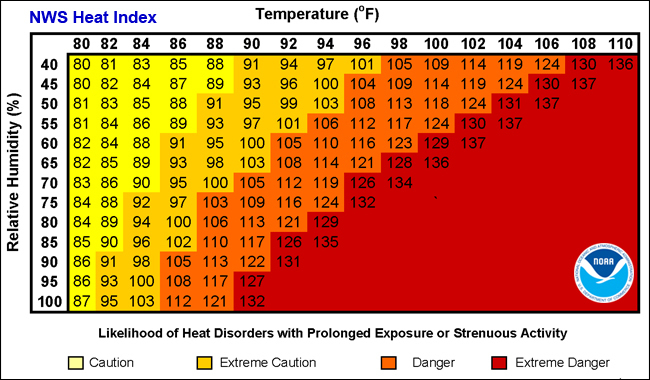Here’s the latest edition of Weather whys, a series of posts by Braniff Davis explaining the science behind weather phenomenon affecting Texas.
A reader asked us a great question on Eric’s post this morning about the meaning of a heat index. In a place as hot and humid as Houston, we see meteorologists refer to the heat index all the time, saying things like, “The air temperature is 97 degrees, but the humidity makes it feel like 107 degrees outside.” But what does this actually mean?
With heat indices, there’s a little bit of meteorology—and a little bit of perception. The heat index is an ‘apparent temperature,’ or a measure of how hot air actually feels against your skin. When our bodies sweat, that sweat evaporates off of our skin into the atmosphere. This evaporation of moisture releases latent heat away from the body and, in turn, cools you down. However, when there is already a lot of moisture in the air, the sweat doesn’t evaporate as easily. This makes it harder for our bodies to cool, and therefore, the temperature you feel on your skin is much hotter than the actual air temperature.
HOW DO WE KNOW HOW HOT IT FEELS?

Heat index is computed using an equation, but we generally just use the values in the table above to quickly determine the heat index, based on the observed temperature and relative humidity. The higher the temperature, and the higher the humidity, the higher the apparent temperature. Using this table, we can quickly see that, on a hypothetical day with an air temperature of 90 degrees F and humidity of 80 percent (not a completely unreasonable scenario in Houston), it would feel like it is 113 degrees F outside. Of course, as the temperature and humidity changes throughout the day, this apparent temperature changes, as well.
An important thing to note is that these values are calculated in the shade. According to the National Weather Service, exposure to full sunshine can increase the heat index by as much as 15 degrees F!
The higher the heat index, the greater you are at risk for heat exhaustion, heat cramps, or heat stroke. Although the heat index is only a perceived temperature, the risks are very real. And since summer is going to be around a while, everyone should familiarize themselves with the signs of heat-related illness. Stay cool!
I would love to see some explanation of the Air Quality/Ozone Warnings that occur periodically throughout the year. What effects do they have on your health and what can you do to minimize the impact, especially if you have to be outside during these times.
Thanks!
Me too!
“on a hypothetical day with an air temperature of 90 degrees F and humidity of 80 percent (not a completely unreasonable scenario in Houston)” Actually, this would be a very rare scenario in Houston, as it would imply an 83 degree dew point. In fact, I am not sure if this temperature/dew point combo has ever been observed in Houston.
True…though, with very moist soil, it is possible. Point being, high temp and high RH = very high heat indices. Even at 70% humidity, the heat index in that scenario would be 105 degrees.
Okay, so at what humidity does 90 actually feel like 90? And 100 like 100? Is it about 30%?
It depends on your temperature and humidity values–90 feels like 90 at around 37% humidity, and 100 feels like 100 at around 25% humidity. The more arid the conditions, the more rapid the cooling on your skin, which leads to heat index values that are actually lower than the air temperature. If you ever want to do a quick calculation, go here: http://www.wpc.ncep.noaa.gov/html/heatindex.shtml
Thanks for the chart and for your explanation.
But I have a suggestion. 100º at 30% feels like 100º at 30%. Otherwise, we’re referring to some phantom standard for what 100º or 80º “feels like,” without humidity taken into account, when such a standard clearly does not exist. That’s the whole concept behind heat index, right? It changes depending on humidity. But we contradict ourselves, saying “it feels like 100º.”
Or as an alternative, just use a raw number, like 100 or 80, without the “degrees” designation. Just “the heat index is 80,” or “the heat index is 100.” That way, we don’t defy all our algebra teachers by leaving out part of the equation.
Just sayin’ …
In my view, relative humidity is very confusing and should NEVER be used by the TV media. Some of the most oppressive temperatures and humidity combos occur when the relative humidity is just 38%. For example, at 105 degrees and 38% relative humidity, the temperature feels like 119! But 38% humidity at 90 degrees. your heat index is just 90 as Braniff mentions. Confusing? I would agree. The concept of RH is lost on the average person and should be avoided.
I find it reassuring that NOAA shares my sensibility that, once you’re talking over 80 degrees Fahrenheit and 40% humidity, caution is warranted.
Eric, are we looking at a possible conservation alert from ERCOT due to the heat, just like we had back in 2011?